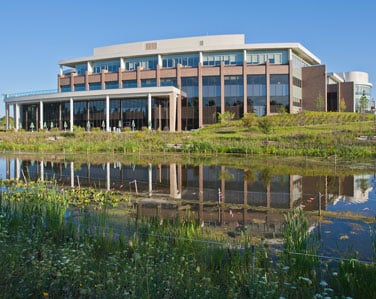An Integrated HVAC Solution
“The Mammoth brand rooftop systems are integrated into the architecture of the building roofs and contain all of the HVAC equipment,” said Jeff Wooten, LEED AP, principal with Griffin International, and the Nortek Air Solutions sales representative on the project team. “They included evaporative condensing DX systems, which are some of the most efficient air conditioning systems built, with significant energy benefits. The Nortek Air Solutions rooftop systems also incorporate FANWALL TECHNOLOGY air handling equipment — one of the most efficient ways to move air — and high-efficiency boilers to support the sustainable design requirements of the Delta Dental campus.”
UVC lamps, mounted in the airstream, help to provide the purest air possible, while minimizing drain pan and coil maintenance. In addition, the evaporative condensing system uses Dolphin® chemical-free water treatment, thereby avoiding the use and handling of toxic chemicals.
The boilers in each system are cross-connected for redundancy. The rooftop system on top of the new building also includes domestic water heating to accommodate both buildings. A third Mammoth brand system — located in the existing mechanical room in the renovated building — features an evaporative condensing air conditioning system, sized at 44,800 cfm to augment the load on the building.
Staged Construction
Construction on the two main buildings was staged, in part so that Delta Dental employees could remain on site. The three-phased project began with construction of a remote data center in the back of the site. The new office building was then constructed.
“The new building was completed first so that workers could be relocated there before the old building was renovated,” said Peter Smeekens, senior project manager with Walbridge, the construction management firm that led the project. Delivery of the three Nortek Air Solutions Mammoth brand systems was also staged to meet the construction schedule.
“The overall coordination with John E. Green Company, the installing contractor, went well and as planned,” Smeekens said. “John E. Green Company did a fine job with the installation and Griffin International provided excellent support as the Mammoth representative,” added Kemp of Kahn Associates. “Overall, the installation went very smoothly.”
Commissioning: A Joint Effort
Walbridge’s proprietary V-Start program initiated the commissioning effort for the mechanical systems at the Delta Dental campus. “Following our documentation of mechanical equipment metrics, commissioning of systems across the facilities was a joint process,” Smeekens of Walbridge said. Third-party commissioning on the facilities was provided by Albert Kahn Associates for the two office buildings and ThermalTech Engineering of Cincinnati for the remote data center.
Delta Dental looks forward to many years of occupant comfort, reliable service and energy efficiency from the Ultraline Custom-Packaged Rooftop Systems.
LEED Point Specifics
The two Ultraline custom-packaged systems on the roofs and the mechanical systems located inside the mechanical room of the renovated building all contributed to the Delta Dental campus earning LEED Gold certification. Specifically, the units contributed to outdoor air delivery monitoring (EQc1), which supports occupant comfort and well-being as well as overall building energy efficiency. They also contributed to EAc1, Optimize Energy Performance, which reduces the building operational costs when compared to standard HVAC systems. One point was earned for Outdoor Air Delivery monitoring and three for Optimize Energy Performance.
“The efficiency of the Ultraline air conditioning systems contributed to the overall building performance which, when compared to ASHRAE 90.1 Appendix G baseline, was able to provide an energy cost savings of approximately 14.7 percent,” Kemp said.
In addition to the high-efficiency air conditioning and boiler systems, additional LEED program credits were granted based on a number of sustainable design features at the Delta Dental campus. These included the use of both vegetative and white-membrane roofs that minimize the heat island effect, reduce storm water runoff, filter pollutants, and provide natural thermal insulation. Other sustainable design elements included thermally efficient windows, low-energy lighting, and daylight harvesting to reduce electricity consumption.



